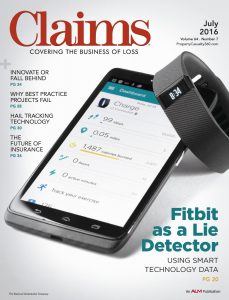- July 14, 2016
- Posted by: BlueSkies
- Category: Forensic Meteorology
Last spring we wrote about the capabilities of dual-polarization radar to identify and distinguish between regions of different types of precipitation within thunderstorms and winter weather events (see “Seeing in the Dark”). This powerful technology provides valuable information to operational meteorologists deciding whether to issue a warning for damaging weather and to forensic meteorologists reconstructing that weather and its impact.
It is also used by the dozens of online hail track products marketed to both construction contractors and insurance claims investigators. These automated hail track products can provide a useful first estimate of hail impact, but they are far from perfectly accurate.
Megan Walker Radtke, chief meteorologist and climatologist here at Blue Skies, recently published an article in Claims Magazine discussing the use of hail track products for insurance claims investigation, including when they should be used with caution.
Check out the article in Claims Magazine’s July digital edition.

